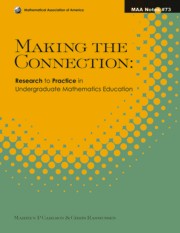Book contents
- Frontmatter
- Preface
- Contents
- Part 1 Student Thinking
- Part 2 Cross-Cutting Themes
- 2a Interacting with Students
- 13 Meeting New Teaching Challenges: Teaching Strategies that Mediate Between All Lecture and All Student Discovery
- 14 Examining Interaction Patterns in College-Level Mathematics Classes: A Case Study
- 15 Mathematics as a Constructive Activity: Exploiting Dimensions of Possible Variation
- 16 Supporting High Achievement in Introductory Mathematics Courses: What We Have Learned from 30 Years of the Emerging Scholars Program
- 2b Using Definitions, Examples and Technology
- 17 The Role of Mathematical Definitions in Mathematics and in Undergraduate Mathematics Courses
- 18 Computer-Based Technologies and Plausible Reasoning
- 19 Worked Examples and Concept Example Usage in Understanding Mathematical Concepts and Proofs
- 2c Knowledge, Assumptions, and Problem Solving Behaviors for Teaching
- 20 From Concept Images to Pedagogic Structure for a Mathematical Topic
- 21 Promoting Effective Mathematical Practices in Students: Insights from Problem Solving Research
- 22 When Students Don't Apply the Knowledge You Think They Have, Rethink Your Assumptions about Transfer
- 23 How Do Mathematicians Learn To Teach? Implications from Research on Teachers and Teaching for Graduate Student Professional Development
- About the Editors
18 - Computer-Based Technologies and Plausible Reasoning
from Part 2 - Cross-Cutting Themes
- Frontmatter
- Preface
- Contents
- Part 1 Student Thinking
- Part 2 Cross-Cutting Themes
- 2a Interacting with Students
- 13 Meeting New Teaching Challenges: Teaching Strategies that Mediate Between All Lecture and All Student Discovery
- 14 Examining Interaction Patterns in College-Level Mathematics Classes: A Case Study
- 15 Mathematics as a Constructive Activity: Exploiting Dimensions of Possible Variation
- 16 Supporting High Achievement in Introductory Mathematics Courses: What We Have Learned from 30 Years of the Emerging Scholars Program
- 2b Using Definitions, Examples and Technology
- 17 The Role of Mathematical Definitions in Mathematics and in Undergraduate Mathematics Courses
- 18 Computer-Based Technologies and Plausible Reasoning
- 19 Worked Examples and Concept Example Usage in Understanding Mathematical Concepts and Proofs
- 2c Knowledge, Assumptions, and Problem Solving Behaviors for Teaching
- 20 From Concept Images to Pedagogic Structure for a Mathematical Topic
- 21 Promoting Effective Mathematical Practices in Students: Insights from Problem Solving Research
- 22 When Students Don't Apply the Knowledge You Think They Have, Rethink Your Assumptions about Transfer
- 23 How Do Mathematicians Learn To Teach? Implications from Research on Teachers and Teaching for Graduate Student Professional Development
- About the Editors
Summary
The purpose of this chapter is to describe how computer-based tools can help students in the doing and learning of mathematics, and to provide specific examples that illustrate the way in which well-designed technologies can support mathematical discovery and understanding. I begin with an example.
Task. Take the three vertices of a triangle ABC and reflect them each across the opposite side of the triangle to obtain a new “reflex” triangle DEF (convince yourself you always do indeed get a new triangle!). Repeat the process. Most people who have seen this problem conjecture that the reflex triangle, after several iterations, converges to being equilateral. But I thought it was a perfect problem for The Geometer's Sketchpad, which effortlessly allows an arbitrary triangle to be iteratively “reflexed” and its measurements to be computed. I dragged vertex A after producing DEF and quickly realized that the equilateral conjecture was false, for I could produce a DEF that was a straight line! And more: DEF seemed to change in a very chaotic way as I continuously dragged vertex A. When, if ever, would the figure become equilateral? When would it not? How did the “function” behave?
At this point, I realized that I needed some kind of measure of the degree to which the triangle had become equilateral, especially since the reflex triangles were getting increasingly large–exploding off the screen–as the iterations increased.
- Type
- Chapter
- Information
- Making the ConnectionResearch and Teaching in Undergraduate Mathematics Education, pp. 233 - 244Publisher: Mathematical Association of AmericaPrint publication year: 2008
- 2
- Cited by



